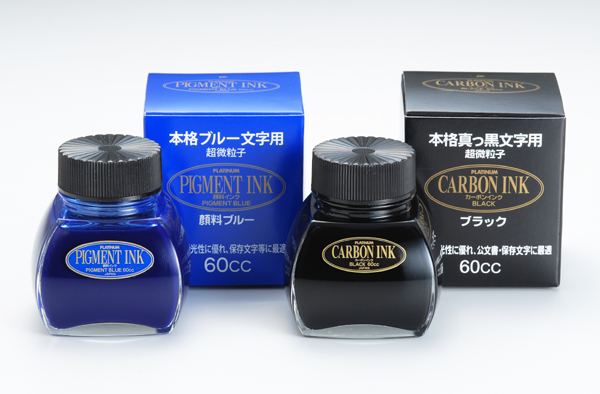Fountain pen ink
Ink is an integral part of fountain pens. The ink also changes the writing feel of the fountain pen. This is because ink not only colors the paper, but also acts as a lubricant between the nib and the paper. Letters written with fountain pen ink have an ancient and tasteful look that was created by extracting natural ingredients, even though it is now made artificially. It has a warmth and charm that other writing instruments can never produce.
 |
| Ink Types |
How to Select Ink
There are more than 100 types of ink available in Japan today. More and more people are choosing not only fountain pens but also ink with particular care. In principle, you should use ink made by the same manufacturer as your fountain pen, but in the case of vintage fountain pens, the composition of the ink may not match, even if it is made by the same manufacturer, so please check with a specialty store before making your choice. In the U.S., there seems to be a booklet by Mr. Gregory Clark that summarizes and sells the color, PH, water resistance, and light resistance of all 134 types of inks sold in the U.S. For your reference.
Ink Types
- Blue black (B.B. ink)Blue black ink, which accounts for 50% of ink consumption, is the best among all inks because it does not fade in sunlight or moisture, is highly waterproof, and is ideal for permanent record keeping. It is also waterproof, making it ideal for permanent record keeping. The origin of this ink dates back to the 2nd century, and its widespread use dates back to the 12th century. In the beginning, it was made from nuts and sap, and in the 16th and 17th centuries, it was also added to wine and beer as an anti-mold agent. The present ink was perfected in the 19th century. Its manufacturing process, blue-black ink is not a mixture of blue and black ink, but uses the oxidizing effect of ferrous ions oxidizing to ferric ions to produce black precipitation, to which dyes and sulfuric acid are added to make it easier to write. The color fixing mechanism is different from that of other color inks that use carbon or pigments. The age resistance of letters is attributed to this component of blue black. In handling, note that if bottled, it will oxidize and precipitate tannin iron compounds if left with the lid released or if it gets old. Spare ink should be cleaned (rinsed with water) regularly (once every 3-4 months) because once it hardens, it is insoluble in water.
- Black inkBlack ink is water-soluble, but once it hardens, it cannot be removed with water. Spare ink is also insoluble in water once it hardens, so please clean (rinse with water) it regularly (once every 3-4 months) before use.
- Carbon BlackMany people avoid using fountain pen ink because it bleeds, but if you use this carbon black ink, it will not bleed with water. Recently, we have seen commercials for PC printers that say, “Even when printing on plain paper, the ink does not bleed because it is a pigment-based ink. However, if you write with a fountain pen filled with this ink on the output from a non-pigment-based PC printer and then dip it in water, you will find that the printed area will not be blurred. The part printed by the printer blurred, but the carbon black ink did not. Carbon black ink uses pigment black, so it does not fade due to sunlight, humidity, or moisture, making it the best ink for permanent preservation of records. However, since it is not water soluble, once it dries, it will not dissolve again, so the best way to use it is to use it daily to flush out the ink. It should also be cleaned (rinsed with water) about once every two months.
- Pigment-based inkThe above-mentioned carbon ink is also pigment-based ink, so it belongs to this group. This pigment-based ink is not only excellent in weather resistance and water resistance like carbon ink, but also has a unique writing feel. This blue ink, like carbon ink, is designed to maximize the characteristics of pigments and to achieve the best possible color. The nibs should be cleaned (rinsed with water) once every two months or so.
- CobaltB.B. ink with tannic acid and ferrous sulfate removed to eliminate precipitates and enhance the vividness of colors. It flows well from the nib, but because it is a dye-based ink, it fades in sunlight, moisture, and water, making it unsuitable for record-keeping purposes.
- Color ink (red, black, etc.)This ink is alkaline, unlike B.B. ink and cobalt ink, which are acidic. It has the disadvantage that it can be destained by water and faded by sunlight, but it has the advantages of beautiful colors, flexible number of colors, quick-drying, and no precipitation due to oxidation by the air. Currently, Nakaya sells only black, blue black, and carbon black.
How to use a fountain pen – Avoid ink hardening in a fountain pen
As mentioned above, ink has a tendency to harden, and this can cause the ink to harden in the fountain pen (pen tip), resulting in the pen not being able to write. The best way to prevent this from happening is to use your fountain pen every day and feed the ink into the nib more and more. If you have not used your fountain pen for a while and it has stopped writing, please try to take care of it.

